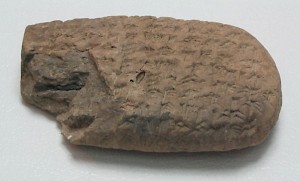Persepolis Treasury Tablets
Persepolis Treasury Tablets: large collection of ancient Persian cuneiform administrative texts, written between 506 and 497 BCE. They are one of the most important sources for the study of the administration of the Achaemenid Empire.

Persepolis was one of the capitals of the ancient Persian empire, founded by king Darius I the Great in 518 BCE. It was excavated by the Oriental Institute of Chicago: Ernst Herzfeld and F. Schmidt were working in Persepolis from 1931 to 1939. During the excavations, two archives of cuneiform texts were discovered.
The collection that is known as the Persepolis Fortification Tablets is older and larger: there are 25,000 to 30,000 of them. Not all of them have been published; after decades of neglect, the project was started again in 2002 (more).
The other, smaller set of tablets is called the Persepolis Treasury Tablets. There are 139 of them, and they describe payments in silver between 492 and 458. One example:
To Shaka the treasurer,
Budkama declares that Herdkama, the Egyptian, was the chief of a team of one hundred laborers, and is entitled to three karšâ and two-and-a-half shekels of silver as his wage. These laborers are working on behalf of Wohuka in Parsa (=Persepolis)
Written by Marduka